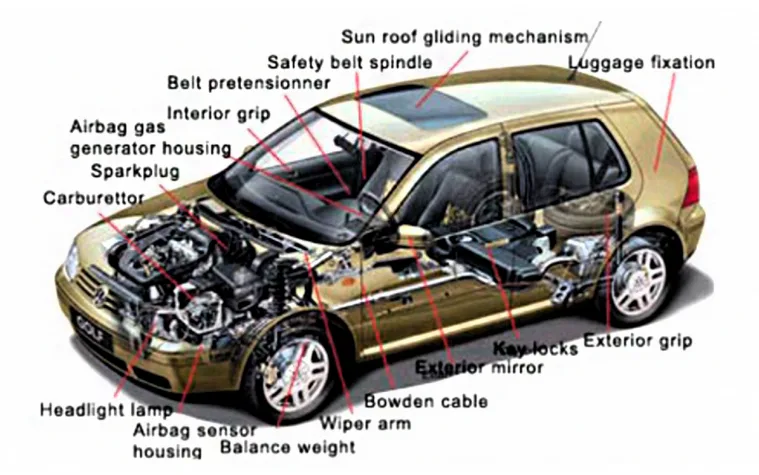この論文要約は、Materials Today: Proceedings, Elsevier に掲載された論文「Automobile Parts Casting-Methods and Materials Used: A Review」に基づいています。
1. 概要:
- タイトル: 自動車部品鋳造 - 方法と使用材料:レビュー (Automobile Parts Casting-Methods and Materials Used: A Review)
- 著者: Madhav Goenka, Chico Nihal, Rahul Ramanathan, Pratyaksh Gupta, Aman Parashar, Joel J
- 出版年: 2020年
- 出版ジャーナル/学術団体: Materials Today: Proceedings, Elsevier, ICMMM 2019
- キーワード: 遠心鋳造 (Centrifugal Casting); ダイカスト (Die Casting); エンジンブロック (Engine Block); ピストン (Piston); Al-Si 合金 (Al-Si Alloys); CGI

2. 研究背景:
現代の自動車産業において、製造業者の最優先事項は、車両重量(カーブウェイト)を削減しながら、NCAP(New Car Assessment Programme)などの厳格な安全基準に準拠するために部品強度を向上させることです。この二重の必須要件により、自動車部品の製造において革新的な製造方法論と高度な材料を模索し、実装する必要性が高まっています。したがって、自動車分野で使用されている鋳造プロセスの範囲と、部品製造に不可欠な材料をレビューおよび評価することが急務となっています。本レビューは、確立された鋳造技術と現代的な鋳造技術、そして自動車工学における材料応用に関する包括的な概要を提供することにより、このニーズに対応します。
3. 研究目的と研究課題:
- 研究目的: 本論文は、自動車部品の製造に利用される多様な鋳造プロセスを明らかにするとともに、これらのプロセスで一般的に使用される材料を説明することを目的としています。さらに、各鋳造方法の長所と短所に関する簡潔な評価とともに、特定の自動車部品に最適な材料を特定しようとしています。
- 主要な研究課題:
- 現在、自動車部品の製造に展開されている主要な鋳造プロセスは何ですか?
- 自動車部品製造のために、これらの鋳造方法論と共によく使用される材料は何ですか?
- 議論された各鋳造プロセスに関連する比較優位性と制約は何ですか?
- 鋳造プロセスと性能要件に基づいて、特定の自動車部品に最適に適合する材料は何ですか?
- 研究仮説: 本論文はレビュー論文であるため、明示的な研究仮説は公式化されていません。しかし、暗黙の提案は、自動車部品用の鋳造プロセスと材料の選択が、性能基準、費用対効果、および生産拡張性の多面的な評価に依存しているということです。本論文は、ダイカストが広く適用可能な方法であり、他のプロセスは特定のアプリケーションまたは材料要件に対して特定の利点を提供すると暗黙のうちに仮定しています。
4. 研究方法:
- 研究デザイン: 本研究は、自動車分野における鋳造方法と材料に関連する既存の文献と業界慣行を統合するレビューベースの研究デザインを採用しています。
- データ収集方法: 方法論は、自動車鋳造プロセスと材料応用に関連する学術論文、業界レポート、および技術文献の包括的なレビューに基づいています。
- 分析方法: 分析的アプローチは記述的かつ比較分析であり、グリーンサンド鋳造 (Green sand casting)、遠心鋳造 (Centrifugal casting)、ロストフォーム鋳造 (Lost-foam casting)、ダイカスト (Die casting)、スクイズ鋳造 (Squeeze casting) を含むさまざまな鋳造技術に関する情報を要約し、統合することを含みます。分析には、各方法の長所と短所に関する比較評価と、各プロセスに通常関連付けられている材料が含まれます。
- 研究対象と範囲: 本レビューの範囲は、エンジンブロック、ピストン、バルブカバー、ホイール、トランスミッションハウジングなどの多様な自動車部品の製造に使用される主要な鋳造方法論(グリーンサンド鋳造、遠心鋳造、ロストフォーム鋳造、ダイカスト、スクイズ鋳造)と材料(鋳鉄、Al-Si合金、マグネシウム合金、チタン鋳物、金属マトリックス複合材料 (MMC)、亜鉛合金)を包含します。
5. 主な研究結果:
- 主な研究結果: 本レビューでは、自動車産業におけるさまざまな鋳造プロセスの応用を解明し、特にアルミニウム合金と亜鉛合金から軽量で取り扱いやすく、費用対効果の高い部品を製造できる能力により、ダイカストが大量生産に広く使用されている方法であることを強調しています。グリーンサンド鋳造は、寸法精度と表面粗さの要件がそれほど厳しくない部品に対する費用対効果の高い代替手段として提示されています。遠心鋳造は円筒形部品に有利であり、多孔性が低減され、冶金学的清浄度が向上した部品を製造することが確認されています。ロストフォーム鋳造は、エンジンブロックや複雑な形状の製造における信頼性で認識されています。スクイズ鋳造は、鋳造部品の機械的特性を向上させ、多孔性を低減する能力があることが注目されています。本論文では、各プロセスおよび部品タイプに関する材料選択基準についても議論しており、高い強度対重量比と熱伝導率のためにAl-Si合金の使用を強調しています。CGI(球状黒鉛鋳鉄)は、エンジンブロックに対して優れた機械的特性を持つため、ねずみ鋳鉄よりも好ましい材料として強調されています。
- 統計的/定性的な分析結果:
- Table 1. Differences in mechanical properties of CGI and Grey cast iron An example of a column heading Grey Cast Iron Compacted Graphite Cast Iron Modulus of Elasticity; GPa 98-110 170-190 Tensile Strength; Mpa 160-320 300-600
- Table 2. Typical die temperatures and life of Al and Mg [16] Parameters Al Mg Max die life (number of cycles) 10,00,000 1,00,000 Die temperature (°C) 288 260 Casting temperature (°C) 660 760
- ピストンの遠心鋳造は、ピストンスカートからヘッドまで硬度が23.7 HRB増加し、線膨張係数が23%減少し、重力金型鋳造と比較して耐摩耗性が70.4%向上しました。
- AlSi6Cu2Mg合金にストロンチウム(Sb)とアンチモン(Sr)を添加すると、流動性がそれぞれ25%と15%減少します。
- データ解釈: 提示されたデータは、さまざまな鋳造プロセスと材料間のトレードオフを強調しています。グリーンサンド鋳造はコスト上の利点を提供しますが、寸法精度と表面品質が犠牲になります。ダイカストは、複雑で軽量な部品の大量生産に優れていますが、金型コストが高くなる可能性があります。遠心鋳造は、高い信頼性が要求される円筒形状に最適です。スクイズ鋳造は機械的特性を向上させ、高性能アプリケーションに適しています。エンジンブロックにねずみ鋳鉄の代わりにCGIを選択することは、表1に定量化されているように、優れた機械的強度によって正当化されます。表2に示す金型寿命と温度の考慮事項は、ダイカストプロセス設計と材料選択における重要なパラメータです。遠心鋳造ピストンで観察された改善は、プロセスの部品性能向上への可能性を強調しています。
- Figure Name List:
- Fig. 1. Aluminium Die Cast Parts.
- Fig. 2. Flow chart of manufacturing of MMC pistons using squeeze casting.
- Fig. 3. The process of squeeze casting.


(c) Plunger moving to reach the gate of molten metal; (d) Plunger moving to completely filling of die cavity.
6. 結論と考察:
- 主な結果の要約: 本レビューでは、ダイカストは比較的高いコストにもかかわらず、広範囲の自動車部品の製造に広範に使用されていると結論付けています。グリーンサンド鋳造は、寸法精度と表面粗さがそれほど重要でない部品に対して、より経済的な代替手段として使用されます。遠心鋳造、ロストフォーム鋳造、スクイズ鋳造などの特殊な鋳造プロセスは、特定の部品要件と材料特性に基づいて展開されます。本論文では、各鋳造方法の重要なプロセスパラメータと材料の考慮事項を説明し、自動車部品製造のための包括的なガイドを提供します。
- 研究の学術的意義: 本レビューは、自動車分野に関連する鋳造プロセスと材料に関する情報を統合することにより、学術的知識体系に貢献します。自動車工学において確立された鋳造技術と現代的な鋳造技術およびその応用に関する包括的な概要を探している研究者やエンジニアにとって貴重な資料となります。
- 実用的な意味合い: 本レビューの結果は、自動車エンジニアや製造専門家が特定の自動車部品に最適な鋳造方法と材料を選択する際に実用的なガイダンスを提供します。プロセスの長所と短所に関する比較分析は、材料推奨事項とともに、部品設計、製造効率、および費用対効果を最適化するのに役立ちます。
- 研究の限界: レビュー論文として、本研究は本質的に既存の文献に依存しており、特定の鋳造プロセスに関する新しい実験データや詳細な分析を提示していません。各鋳造方法および材料に関する分析の深さは、レビューされた文献の範囲によって制限されます。
7. 今後のフォローアップ研究:
- 今後のフォローアップ研究の方向性: 今後の研究努力は、特定の自動車材料および部品に対する個々の鋳造プロセスの最適化に焦点を当てることができます。自動車アプリケーションにおける性能向上と軽量化のために調整された新しい鋳造技術と高度な材料の開発に関するさらなる探求が求められます。
- さらなる探求が必要な領域: 今後の調査の特定の領域には、各鋳造方法のプロセスパラメータの最適化、鋳造性と性能特性が向上した新しい合金組成の開発、プロセス設計と最適化のための計算シミュレーションおよびモデリングツールの適用、自動車大量生産シナリオにおけるさまざまな鋳造方法論の包括的な費用便益分析が含まれます。
8. 参考文献:
- [1] H. Nguyen, "Manufacturing Processes and Engineering Materials Used in Automotive Engine Block," Mater. Sci. Eng. Sect. B, EGR250, pp. 11-23, 2005.
- [2] A. V. Adedayo, "Effects of addition of iron (Fe) filings to green moulding sand on the microstructure of grey cast iron," J. Brazilian Soc. Mech. Sci. Eng., vol. 32, no. 2, pp. 171-175, 2010.
- [3] D. Anantha Padmanaban and G. Kurien, "Silumins: The automotive alloys," Adv. Mater. Process., vol. 170, no. 3, pp. 28–30, 2012.
- [4] G. Chirita, D. Soares, and F. S. Silva, "Advantages of the centrifugal casting technique for the production of structural components with Al-Si alloys," Mater. Des., vol. 29, no. 1, pp. 20–27, 2008.
- [5] N. Periyasamy, "Thermal Analysys and Material Optimization of Piston in IC Engine," no. 3, pp. 1132-1144, 2018.
- [6] Q. Bakhsh, D. Ali, A. Ahmed, M. S. Wahab, K. Kamarudin, and A. A. Raus, "Mechanical Properties, Material and Design of the Automobile Piston: An Ample Review," Indian J. Sci. Technol., vol. 9, no. 36, pp. 5-11, 2016.
- [7] P. Scarber, H. Littleton, and A. Druschitz, "Preliminary Study of Compacted Graphite Iron Engine Blocks Produced by the Lost Foam Casting Process," AFS Trans, pp. 881-890, 2009.
- [8] R. Colás, J. Talamantes-Silva, S. Valtierra, F. Morales, and A. J. Pérez-Unzueta, "Cast-In Hypereutectic Aluminum Liners for Engine-Blocks," J. Manuf. Sci. Eng., vol. 131, no. 1, p. 014502, 2009.
- [9] M. Javidani and D. Larouche, "Application of cast Al-Si alloys in internal combustion engine components," Int. Mater. Rev., vol. 59, no. 3, pp. 132-158, 2014.
- [10] E. Aguirre-De La Torre, U. Afeltra, C. D. Gómez-Esparza, J. Camarillo-Cisneros, R. Pérez-Bustamante, and R. Martínez-Sánchez, "Grain refiner effect on the microstructure and mechanical properties of the A356 automotive wheels," J. Mater. Eng. Perform., vol. 23, no. 2, pp. 581-587, 2014.
- [11] B. Zhang, S. L. Cockcroft, D. M. Maijer, J. D. Zhu, and A. B. Phillion, "Casting defects in low-pressure die-cast aluminum alloy wheels," Jom, vol. 57, no. 11, pp. 36-43, 2005.
- [12] M. V. Kevorkijan, "MMCs for automotive applications," Am. Ceram. Soc. Bull., vol. 77, no. 12, pp. 53-59, 1998.
- [13] S. W. Youn, C. G. Kang, and P. K. Seo, "Thermal fluid/solidification analysis of automobile part by horizontal squeeze casting process and experimental evaluation," J. Mater. Process. Technol., vol. 146, no. 3, pp. 294-302, 2004.
- [15] Wu Shenqing and Li Jun, "Application of ceramic short fiber reinforced Al alloy matrix composites on piston for internal combustion engines."
- [16] Schrader, George F, Elshennawy, Ahmad K, Doyle, Lawrence E, "Manufacturing processes and materials", SME, p.186, ISBN 978-0-87263-517-3.
9. 著作権:
- この資料は、"Madhav Goenka et al." の論文 "Automobile Parts Casting-Methods and Materials Used: A Review" に基づいています。
- 論文ソース: https://www.sciencedirect.com/journal/materials-today-proceedings/vol/22/suppl/C
この資料は上記の論文に基づいて要約されており、商業目的での無断使用は禁止されています。
Copyright © 2025 CASTMAN. All rights reserved.